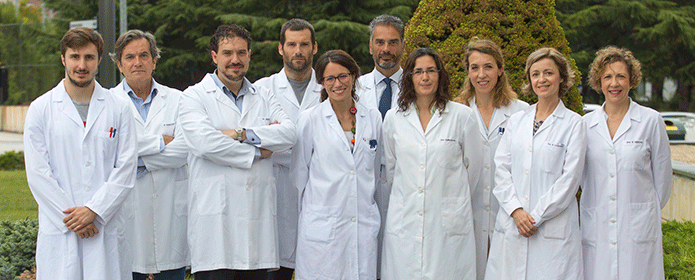New combination immunotherapy strategy more effective for lymphoma treatment
The work of the Cima and the Clínica Universidad de Navarra also discovers new genetic mechanisms involved in this disease.

Among the overwhelming diversity of tumor subtypes that can affect the immune system and the life of a hematologic cancer patient, diffuse large B-cell lymphoma is one of the most common. It accounts for 30 to 40 percent of non-Hodgkin's lymphomas and, although it can occur at any age, it tends to affect mainly patients in their 60s. They are aggressive lymphomas, in which approximately 1 in 3 patients do not respond to conventional therapies, so it is essential to advance in their knowledge, to find more effective treatments.
Researchers from the Cima and the Clínica Universidad de Navarra have uncovered new pathogenic mechanisms involved in the development of this lymphoma. "Specifically, we have identified genetic "addictions" to which the tumor "hooks on" to survive and molecular camouflage strategies that could become its own Achilles heel," explains Dr. Sergio Roa, researcher of the Hemato-oncology Program of the Cima University of Navarra and co-director of the study. The results have been published in Bloodone of the most important scientific journals in the field of hematology.
"With an eye always on the mutations that recurrently appear in lymphoma patients, we have recapitulated in animal mouse models up to three of the molecular pathways most frequently altered in this disease," explains Dr. José Ángel Martínez Climent, co-researcher of the study.
According to the authors, "the result of this work provides a better understanding of the origin and progression of diffuse large B-cell lymphoma, as it reveals the genetic mutations core topic used by tumor cells to survive, proliferate and escape the patient's own immune defenses".
Progress towards a clinical essayOnce the molecular alterations had been described, scientists at Cima and Clínica Universidad de Navarra designed a new immunotherapy strategy that combines two monoclonal antibodies. "It involves the joint administration of anti-CD20 (as an 'arrow' against the tumor) and anti-PD1 (as a 'revitalizer' of the immune cells that fight the tumor), which are already approved for clinical use in other types of cancer. The novelty is that this immunotherapy combination in our lymphoma animal model has shown very encouraging results, which we present as a preclinical concept test . Therefore, it is a therapeutic option that could soon reach patients with this subject aggressive lymphoma in the form of future clinical trials," suggests Dr. Roa.
goal From now on, researchers will focus on analyzing the molecular mechanisms and the importance of the tumor microenvironment that condition the response to this immunotherapy subject , with the aim of "learning more and designing better" therapeutic alternatives for this disease.
The work directed at Cima, whose authors belong to the CIBER Cancer CIBER (CIBERONC), has been supported by "la Caixa" and Fundación Caja Navarra, the State Agency of research and ERDF funds from the European Union, among other public and private institutions.
-
reference letter bibliography
Blood 2019 133:2401-2412; doi: https://doi.org/10.1182/blood.2018889931
